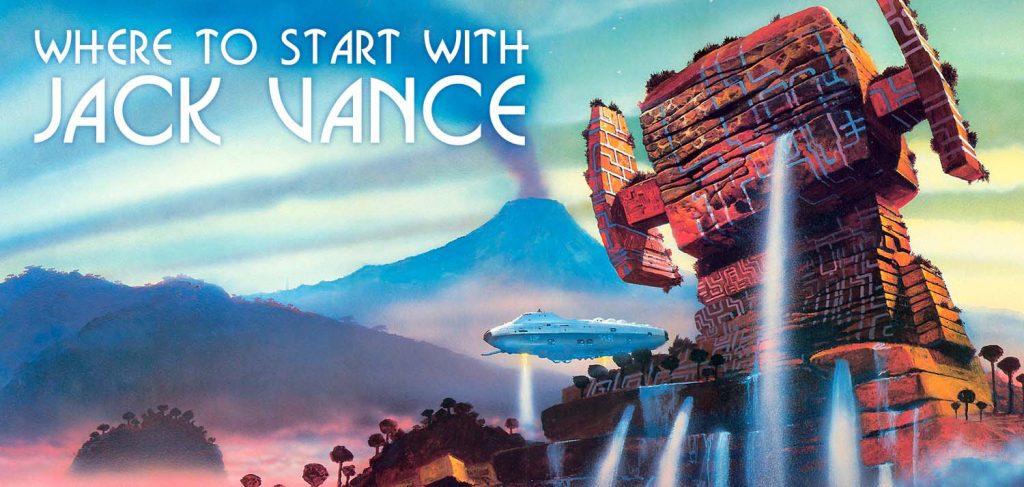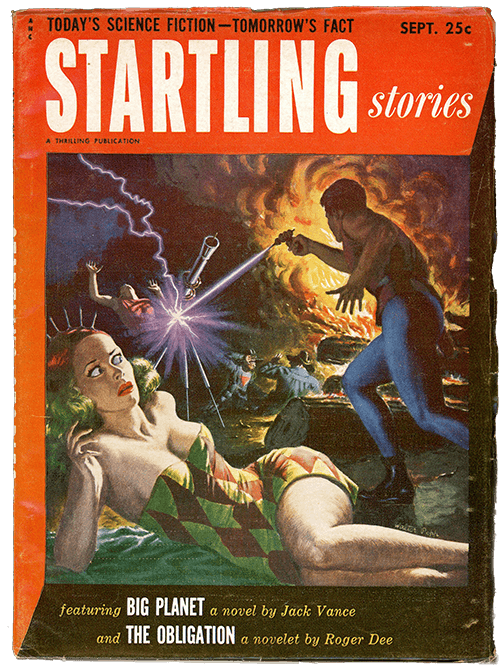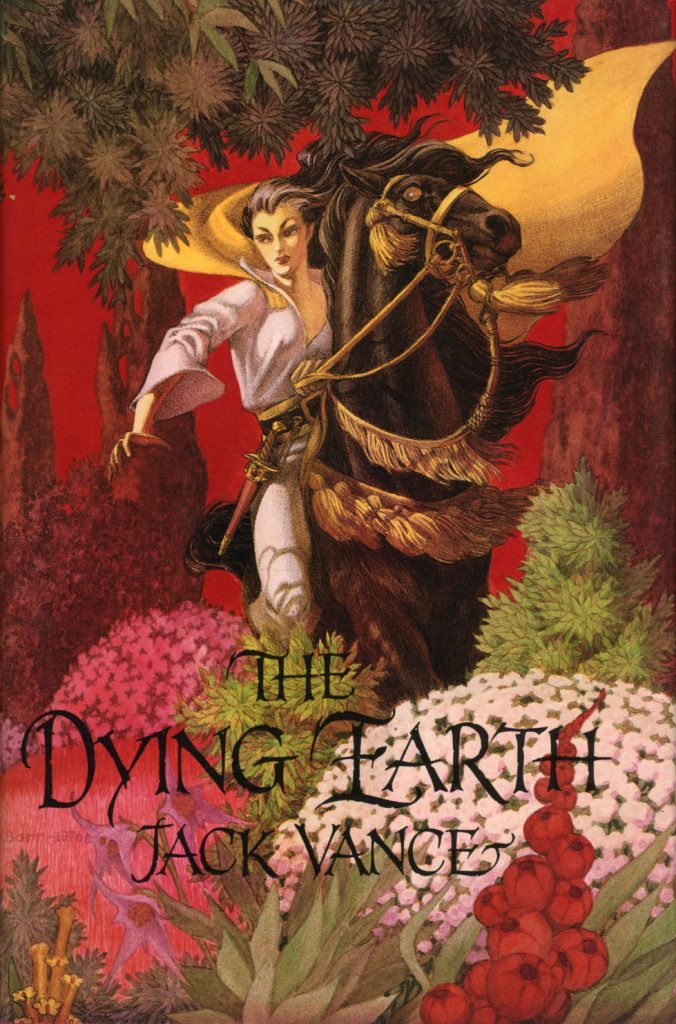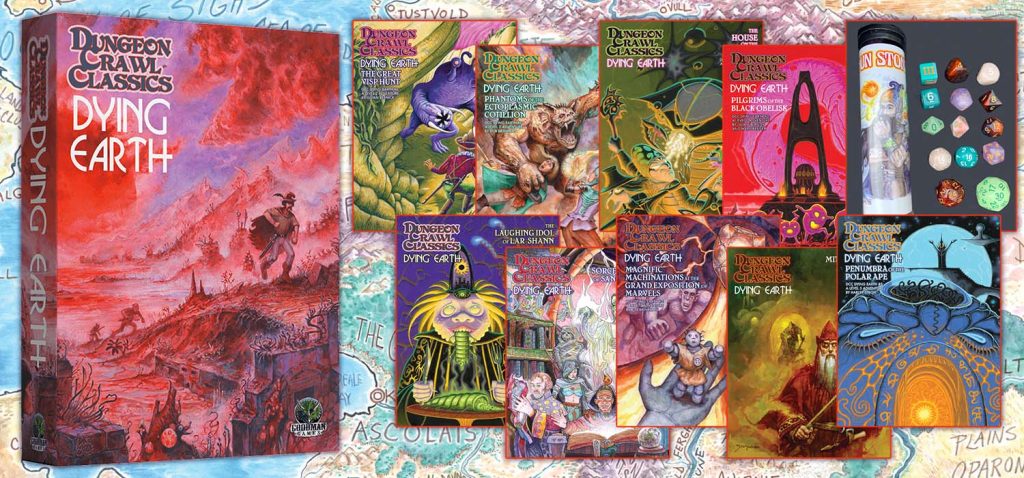We’re celebrating the release of DCC Dying Earth all this Month with articles in honor of Jack Vance.
Where to Start With Jack Vance
by Bill Ward
John Holbrook “Jack” Vance (1916-2013) was an extraordinarily prolific and award-winning author across multiple genres, but it is for his work in the science fiction field that he is most celebrated. ‘Science Fiction’ as a genre and marketing category is an extremely big tent—including everything from nuts-and-bolts stories describing the physics of orbital bodies to swashbuckling tales of ray-gun-wielding heroes racing skyships over the ruined landscapes of Mars. Vance’s own unique voice arose at a time when popular adventure stories shifted from the lost corners of the Earth to the unimagined frontiers of space and time, with scientific trappings, exotic settings, and odd terminology seasoning the already familiar dish of two-fisted pulp adventure.
But Vance wasn’t really a pulp writer, though his earliest sales were to places such as Startling Stories and Thrilling Wonder Stories, and his work throughout his career always placed solid plotting, a swift pace, and efficient storytelling at center stage. He emerged in the post-pulp era after WWII, a time of transition away from classic adventure serials toward speculative stories of space travel, alien encounters, and technological progress. Indeed, this period is often termed the Golden Age of Science Fiction, and Vance would become one of its leading lights – and biggest mavericks. Far from writing stories in the Campbellian mode such as contemporaries Frederick Pohl and James Blish, Vance did his own thing, his ‘science’ elements far more focused on biology and anthropology than astrophysics and robotics. Many of his earliest sales are mystery stories in a sci-fi setting, and his debut novel—really an interconnected series of short stories—is about as convincingly described as a fantasy book as is possible, despite it being set on a far-future earth a billion years hence experiencing the last gasp of a dying star.
Like all truly great artists, Vance has a distinctive, near-inimitable, authorial voice; joining the list of other true originals in seeing his surname rendered into an adjective—Vancian. A Vancian story might be said to be a picaresque tale following a strongly motivated and highly-capable protagonist through a series of colorful, imaginative, and occasionally farcical adventures against a kaleidoscopic backdrop of endlessly inventive human cultures. But is in the nature of Vance’s prose, a lyrically spare semi-formal style peppered with odd conjugations and amusingly stilted dialog, that the real ‘Vancian’ tone emerges. A lesser writer would be sunk were he to pen a scene in which a wealthy intellectual and an illiterate bumpkin discoursed on matters philosophical in the very same pointedly correct style—in Vance such scenes are commonplace, and only serve to heighten the subtle absurdist humor that underlies much of his work. So too, reprehensibly roguish characters like Cugel the Clever are rendered palatable by Vance’s use of ironic detachment. When reading much of Vance’s output, we never lose sight that we are reading a story, and the fun of his work is in the manner in which his characters express themselves and how his own drily humorous observations and wild flights of imagination are conveyed. Vance could craft a beautifully evocative descriptive passage with the best of them, but it is in his diction and his dialog that the true strong stuff of Vance leaps out.
So where to start? Jack Vance was enormously prolific, even if one only focuses on his science fiction and fantasy. But he was also remarkably consistent in the sort of thing he wrote, whether it be labeled science fantasy or speculative fiction or space opera, all of it is Jack Vance fiction. And while he wrote numerous series, they generally consist of only a handful of books, and many of them don’t rely on any reading order. This makes it rather easy to recommend Vance to anyone who already has a taste for him—just get more Vance!
An excellent starting point for first-time readers of Vance are his Tales of the Dying Earth, four books connected by their setting and tone and easily obtainable in an omnibus edition that has been in print from Orb for over 20 years now. The Dying Earth is the first book in the series, and Vance’s first published book-length work, and it contains loosely connected short stories of magical cleverness and strange societies in the never-never land of the Earth of the far future. The middle two Dying Earth books, The Eyes of the Overworld and Cugel’s Saga, are the tales of Vance’s most famous anti-hero protagonist, Cugel the Clever, and they greatly expand the landscape of the Dying Earth and highlight Vance’s specialty of compelling serial adventure. Rhialto the Marvellous, fourth and final Dying Earth book, synthesizes everything that came before it in a wild—and wildly funny—series of tales of double-crossing wizards and strange environments, featuring everything from time travel to a voyage to the edge of the universe.
And it’s to the universe that we must turn for the great bulk of Vance’s work, the many, many worlds of his Gaean Reach stories. Far from any sort of highly cohesive setting, these adventure stories of vengeful operators, stranded starfarers, ambitious young men, and the strange societies through which they move are often as vastly separated from one another in time as they are in place. Two great starting points for Vance’s extra-planetary adventure series are the omnibus collections of The Demon Princes (Star King, The Killing Machine, The Palace of Love, The Face, The Book of Dreams) (Scifi Book Club) and Planet of Adventure (City of the Chasch, Servants of the Wankh, The Dirdir, The Pnume) (Orb). Planet of Adventure is certainly aptly named, and is one of the most accessible Vancian sci-fi adventures and the first book I’d hand a fan of Edgar Rice Burroughs or Star Wars. The Demon Princes, a series of five books written at two stages of Vance’s career and widely acknowledged as one of his major works, follows a man on a personal quest for revenge as he tracks down and destroys the five tyrannical grotesques that enslaved his homeworld. Straying toward satire in the later stories, the slight tonal shift may be off-putting to readers approaching the entire work as a whole, but The Demon Princes is one of the major sequences and pieces of world-building in Vance’s Gaean Reach books and a first-rate showcase of his imaginative powers.
Other standout series in Vance’s Gaean Reach are Alastor, Durdane, and The Cadwal Chronicles, but they might require a bit more hunting of secondary markets to acquire. Thankfully, Vance’s other major fantasy series, the Lyonesse trilogy (Lyonesse/Suldrun’s Garden, The Green Pearl, Madouc) is another that is easy to find in an omnibus edition, and might be the place to start for lovers of traditional and high fantasy. This is Vance’s take on Arthurian Romance, tinged with Celtic myth and Atlantean legendry, sprinkled with a heady mix of Vancian invention (fans of The Dying Earth might notice a few crossovers). Published later in his writing career, they are longer, more voluminous novels compared to many of Vance’s more pulpishly paced scifi works, with the language and tone calibrated to match the subject matter.
With all this talk of series – of which Vance wrote a great many—it might be surprising to note that Vance was probably most celebrated for his many classic, award-winning, and genre-defining standalone works. In The Languages of Pao Vance describes a society’s deliberate transformation through engineered languages, in The Blue World he tells of a technological rebellion on a low-resource and socially stratified ocean planet, and in To Live Forever (aka Clarges) an immortal posing as his own clone must survive a beleaguered far-future utopia that controls its citizens with the promise of eternal life. Many of Vance’s early career-novellas were published as short novels, again proving themselves classics of the genre, such as The Five Gold Bands, The Last Castle, and The Dragon Masters—the last a tale of conflict between humans and aliens with mirrored civilizations based on genetically engineering one another!
Vance’s fantasy and science fiction output was considerable, but it isn’t all that difficult to navigate when you realize the common themes and motifs that permeate much of his work. A great amount of his adventure fiction reflects magazine-style pacing, with short, efficient, episodic novels—but his fast-moving plots rely more on cleverness, strange reversals, and revelations of information about his wonderfully imagined societies than they do on violent conflict. Many of his tales are coming-of-age stories, and nearly all of them take delight in creating unique, unusually stratified societies with strange norms and bizarre rituals that nonetheless somehow feel human. And perhaps that humanity is the common thread, as Vance was far more interested in creating a myriad of human possibilities than speculating on alien behavior or the specifics of technology. Above all, it’s Vance’s distinctive voice, his one-of-a-kind manner of expression, that keeps fans returning again and again to the many astounding worlds that only he could create.







